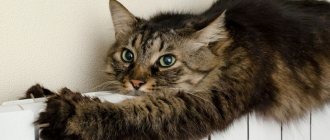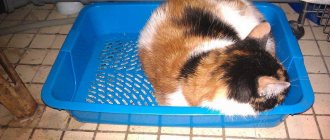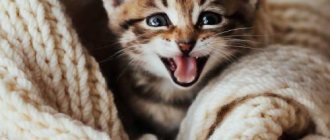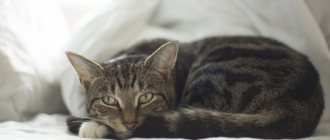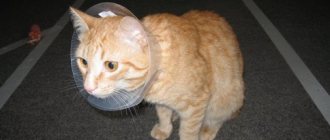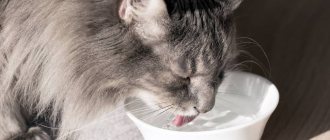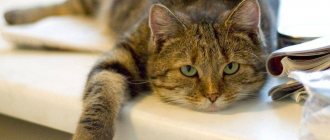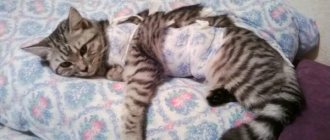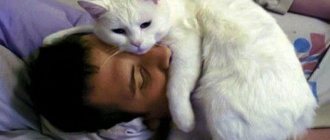Reasons why a cat may tremble
Non-pathological underlying causes of strange muscle contractions are not dangerous and can be easily prevented by eliminating predisposing factors.
Joy and positive emotions
There are several reasons why a cat trembles:
- reaction to a favorite treat;
- excitement during games;
- interest in birds or insects seen through the window;
- joy at the sight of the owner or a new toy.
Domestic cat
In these cases, the deviation is temporary and goes away on its own after a short period.
The blanket is in the way
Some pets hate any foreign things placed on them.
Cat in a blanket
Foreign blankets include blankets that are put on after surgery. By contracting muscles, the cat tries to get rid of discomfort.
The cat is frozen
Comfortable temperature conditions for furry pets include the following indicators:
- for newborn babies - 31 degrees and above;
- for older kittens - 24 degrees.
Wide open windows, lack of heating, and drafts cause the cat to tremble, trying to warm up. Secondary symptoms of hypothermia include drowsiness, apathy, decreased heart rate, breathing and temperature.
Important! In the summer heat, your cat may experience chills after swimming. In a light breeze it can freeze.
Fatigue after exercise
Prolonged physical activity, chasing a butterfly or a bird leads to a problem. The deviation resembles the reaction of the human body to excessive physical activity: voluntary contractions of the leg muscles after running. After rest, the symptoms disappear.
Important! If, after a full sleep, the pet continues to tremble, then a visit to a veterinarian is necessary.
The animal got scared
If a cat is shaking with small tremors, she meows continuously, tries to hide in a secluded place, behind the sofa, and the hair on the back of her neck stands on end, then she is simply scared.
Fear is provoked both by the arrival of strangers and by a working vacuum cleaner or mixer.
Sexual arousal
At the peak of hormone production, cats shake, make loud noises, and rub against their legs or furniture.
It is easy to recognize sexual arousal: males begin to actively mark their territory, females experience swelling in the genital area.
Puberty of a cat
Why does a cat shake after 5 months: one of the root causes includes growing up and puberty. In young animals, the unusual condition causes unreasonable fear and stress.
Cucumbers and cats
Many people are still interested in knowing why cats are afraid of cucumbers. Now let's try to understand this issue. Nowadays you can see many videos where the owner puts a cucumber next to the cat, and she gets scared of it. Why is this happening? Most likely, if a person gives the pet some other unknown object or vegetable, the reaction will be the same. The thing is that the animal simply did not expect to see a cucumber in this place. After all, the cat regards the place where it eats as safe. That's why she's calm and relaxed here. The appearance of a long, green, incomprehensible object at a very close distance is perceived as a threat. Also in appearance this vegetable resembles a snake. She is also the cat's worst enemy.
So, why are cats afraid of cucumbers? After analyzing the situation, zoologists came to the conclusion that such a reaction is natural for the animal. It’s just that cats are not used to cucumbers; they rarely come across them. If a green vegetable appears at the time of eating, that is, when the animal is completely relaxed, then this causes severe fear, which is manifested by a standard reaction - a sharp jump, flight or hissing.
Trembling as a warning sign
The pathological appearance of tremors is associated with a variety of diseases. Without diagnosis, it is difficult to determine the original source - many pathologies have similar symptoms.
Trembling croup and generalized tremor
Why does a cat shake its tail as if marking?
Muscle contractions are the consequences of damage to the spinal column, deformation changes in its structure, stenosis in the spinal canal, malignant or benign neoplasms.
Important! Lack of professional help and further development of the disease can lead to paralysis.
Inflammatory process
The penetration of pathogenic microflora provokes inflammation and febrile syndrome. Most often, the phenomenon occurs in the postoperative period and manifests itself:
- swelling of the suture;
- suppuration and release of ichor from the wound;
- vomiting, refusal to eat;
- pet's indifference.
Calcivirus infection
A healthy cat may shiver as if it were cold with a latent form of the disease. When the disease becomes chronic, it leads to the appearance of a characteristic clinical picture:
- discharge from the nasal passages and organs of vision;
- intermittent claudication, lethargy, apathy;
- Immunity impairment provokes relapse and transition to the acute phase of the pathology.
Important! The danger to the health of cats is the rapid course of the acute phase of the disease and the addition of secondary pathologies. The prognosis is unfavorable.
Central nervous system disorders
Why do cats tremble when the central nervous system is damaged: the source may be epilepsy, meningitis or encephalitis. Common symptoms of these diseases include:
- rapid breathing and increased heart rate;
- bouts of vomiting;
- strong secretion of saliva;
- convulsions, unsteadiness of gait;
- feverish syndrome, anxiety.
Salivation
Important! The complex course of central nervous system diseases ends in paralysis.
Subclinical form of panleukopenia
The course of the pathological process leads to the occurrence of clinical manifestations:
- lethargy, increased temperature;
- refusal to eat and drink - against the background of constant thirst;
- attacks of vomiting;
- increased gas formation and diarrhea.
The latent course lasts 10 days, after which it becomes clear why the kitten is shaking involuntarily.
Hidden period of rhinotracheitis
Incubation time takes about 7 days, the primary symptoms of the pathology are characterized by:
- loss of appetite, apathy;
- discharge from the nasal passages and eyes - later the contents become purulent-mucosal;
- ulcerations form on the tongue, and a parenchymal form of keratitis forms.
Lack of vitamins
The kitten may tremble due to a deficiency of nutrients. Insufficient intake of B vitamins causes symptomatic manifestations:
- muscle contraction, lethargy;
- growth slowdown;
- dulling of fur;
- peeling of the skin.
Important! Vitamin B enters the body through food or mother's milk. It is responsible for the normal functioning of the nervous system, stress prevention, and metabolic processes in the body.
Metabolic disorders
Problems with metabolism lead to the development of:
- eclampsia - convulsive syndrome occurs during or after childbirth and varies in intensity;
- hypoglycemia - a reduced amount of glucose in the bloodstream causes convulsive muscle contractions, a semi-fainting state, and the cat tries to sleep non-stop.
Why does a cat shake after sterilization?
Initially, the pet will have problems with coordination of movements and involuntary muscle contractions. The deviation refers to a normal reaction to drugs administered during surgery; after a few hours it disappears spontaneously.
Sterilization
The owner needs to monitor the animal’s condition throughout the recovery period after sterilization - if the pet continues to shudder, fainting and vomiting, then a consultation with a veterinarian is necessary.
Signs of imminent death
You can know that a cat is dying by the presence of a combination of certain symptoms. If your pet is over 12–14 years old, then you need to carefully monitor its behavior and health. Some felines live up to 25 years, but this happens very rarely.
Before you prepare for the worst, you should take him to the vet. It is likely that the pet is simply seriously ill, but it can be cured. Timely therapy is important for recovery, so do not delay going to the clinic or calling a specialist at home. For example, older cats often develop chronic pathologies that are similar to signs of impending death. However, if remission is achieved, the animal can live several more years without suffering or pain.
But even if medical intervention does not help, the doctor will advise how to properly care for your friend and prescribe medications to relieve symptoms. If you don’t have enough time to carry out supporting manipulations yourself, the cat can be placed in a clinic where he will be provided with the necessary care.
Loss of appetite is an alarming symptom
A cat's eating behavior changes dramatically before death. She eats little or refuses food at all, and then even water. The following signs should alert you:
- untouched food in a bowl;
- absence of excrement in the tray for two or more days;
- feces containing blood;
- darkening of urine.
After some time, hunger makes itself felt with sunken sides and physical exhaustion. The hair begins to fall out, the pet is no longer active and constantly lies down. Due to weakness, control over the muscles of the intestines and urinary tract is reduced. There may be traces of feces left on the floors of your home.
Difficulty breathing is a sign of the approaching end
Other symptoms of a cat dying are changes in breathing. The heart can no longer work fully, so the amount of oxygen entering the lungs and blood decreases. The pet draws in air heavily and rapidly, trying to make up for the losses. In a healthy animal, the frequency of breaths per minute is 20–30. Shortness of breath, weak or infrequent breathing are symptoms of imminent death. It is not difficult to determine the indicator; just use a stopwatch and count the number of chest rises per minute.
Decreased heart rate and blood pressure are dangerous symptoms
Signs that a cat is dying include a slowing heart rate (normally 140–122 beats per minute) and a decrease in blood pressure. Changes in these indicators occur due to difficulties in pumping blood by the heart and, as a result, overload. You can measure an animal's pulse like this:
- place your palm on the left side behind the front paw;
- count the number of beats in 15 seconds;
- calculate the heart rate per minute by multiplying the resulting figure by 4. If the number of beats is less than 60, then this sign indicates the cat’s approaching death.
Unfortunately, it is impossible to measure your pet’s blood pressure at home without special equipment.
shutterstock
A specific smell is a sign of imminent death
A dying cat emits an unpleasant odor. This happens due to a decrease in the performance of internal organs. The elimination of toxins slows down or completely stops. Harmful substances gradually accumulate in the body, a symptom of which is the unpleasant aroma of the animal’s body and mouth.
Reduced temperature
When checking for signs of death in a cat, be sure to measure its body temperature:
- a special ear thermometer;
- a rectal digital device, the tip of which is carefully inserted into the rectum.
The body temperature of a dying cat is significantly lower than 37.7 ⁰C, which indicates a weak heart. When you don’t have a thermometer at hand, you can feel the animal’s paw pads. If they are cool, then this is also a bad symptom.
The process of recovery from anesthesia
The cat is coughing: why it wheezes, the reasons, as if it was choking
Symptoms that occur after surgery include:
- constant attempts to fall asleep in any position;
- lack of coordination; when trying to stand up, the pet twitches and falls on its side;
- hard breath;
- searching for a dark place;
- involuntary release of urine and feces;
- salivation.
The pupil is dilated, without reaction to light, the anomaly is present for 1-2 days. The animal fully recovers after anesthesia within 2-3 days.
Cold
One of the basic factors in the manifestation of tremor in a cat is the body’s reaction to exposure to cold. In this case, tremors may occur immediately after swimming or after long walks in winter.
Tremors are caused by severe hypothermia. At risk of hypothermia are cat breeds that are hairless or have thin fur. The owners of such animals should carefully approach the issue of additional insulation of the pet’s body.
When to contact a veterinarian
Why is my dog shaking, lethargic and panting?
A visit to a specialist is justified by the question of why a domestic cat’s body and paws periodically tremble. Veterinarians advise coming to the clinic if the following signs occur:
- aggressiveness;
- lethargy and apathy;
- frequent bowel movements;
- bouts of vomiting;
- intestinal disorders with constipation.
Veterinarian appointment
If the cat continues to freeze for no apparent reason and tries to lie down, then refusal of treatment can lead to serious consequences, even death.
Symptomatic treatment
Therapeutic methods for physiological sources of the problem:
- hypothermia - the animal is warmed up, a light massage is performed, and the wet fur is dried with a towel after washing;
- overheating - cooling with compresses, the cat is allowed to drink on demand;
- stress - removing the source of fear, creating peace and quiet;
- sexual arousal is suppressed with special drugs.
Treatment of the pathological origin of muscle tremors is carried out with antibacterial agents, replenishment of vitamin and mineral deficiencies, and operations to remove tumors.
Furry pets are in excellent health; if the cat begins to shake with small tremors, then you need to undergo a diagnostic examination and find out the original source of the abnormal condition. Ignoring the problem can lead to the development of unpredictable consequences for the health of the animal.
Video
